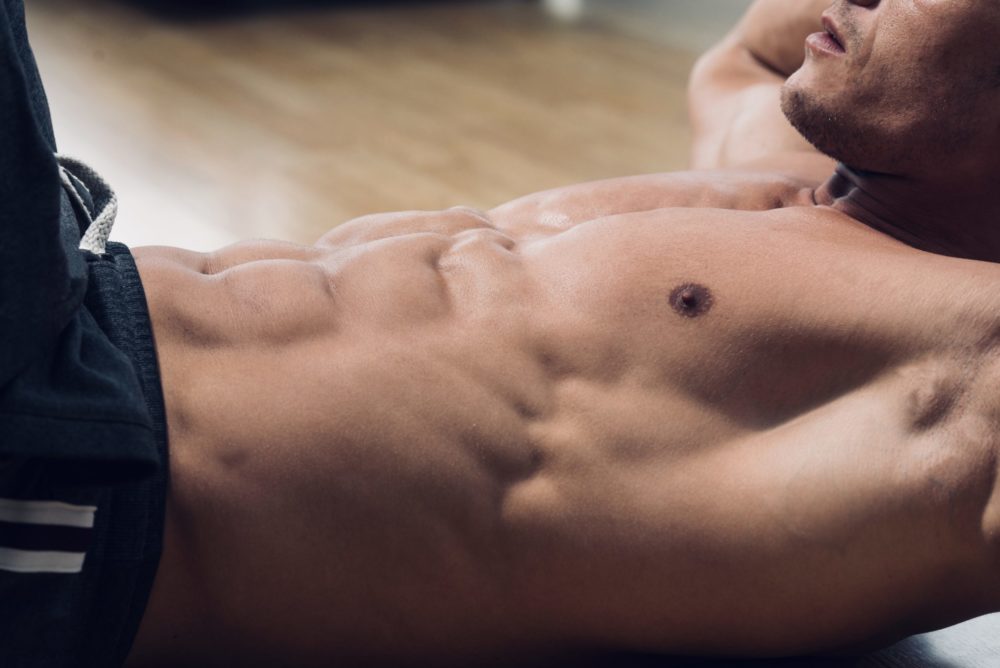You know that to be strong and look great naked you can’t neglect your abs. Though after grinding through sets of big exercises that tax your entire body, it’s easy to fall in to the trap of just “throwing in” a few abs exercises at the end. Stop wasting your time! Here are six abs exercises to challenge even the most advanced lifters.
Slider Body-Saw
Key tips:
- Set yourself in a plank position with your feet on the sliders. A cushion can also be used for your elbows.
- Think “stiff plank of wood”. Pinch your glutes and brace your core – imagine trying to poop, but don’t!!
- Push yourself as far back as you can, creating a long-lever position with your elbows overhead.
- If your back or hips sag or feel pain then you’ve gone beyond your current abilities.
- Drive your elbows down and pull your elbows back under your shoulders. Again, “stiff plank”.
Why these work:
The body-saw can be done with sliders or anything else that slides on your floor. Paper party plates, an old magazine, or a towel on kitchen floor will work just fine. They can also be done in a suspension trainer to switch them up.
Body-saws are a sort of hybrid between an ab roll-out and a long-lever plank, although arguably harder – MUCH harder! There’s a large anti-extension component to these, as throughout you’re resisting your spine collapsing and pelvis tilting anteriorly. As you slide back the lever arm increases and so does the anti-extension component. As you pull back in your lats engage further enhancing the overall effect on your core.
The body-saw will help you develop insane strength through your entire mid-section. They also hit your serratus, which is an important scapular stabilizer and great for overall shoulder health. If it’s too easy just throw on a weighted vest, or to look more badass some chains across your hips.
Landmine Squat Anti-Rotation
Key tips:
- Decide if you’re going to squat or not. Either stand with slightly “soft” knees, or drop in to your best landmine squat to start.
- Press the bar in front and engage your entire mid-section – imagine 360 degrees of air around your spine, and trying to take a poop. But again, don’t!!
- Ark the bar side to side ensuring it moves and not you. Your job here is to resist rotation.
- There might be a little movement, especially if your chest or biceps are on the large side, but the point is to resist.
- Short and sharp breaths work best here.
Why these work:
These are another “anti” exercise. “Anti” exercises are what you’d usually think of as your typical “core” exercises. They basically teach you to hold or resist spine or pelvic movement. We won’t go in to the details here, but in short core exercises involve the deep muscles throughout your trunk on top of the superficial muscles you see on the outside. So as well as improving your core strength, which will carryover to lots of things, you’ll look great naked too.
It’s pretty common to see landmine rotations being done with a more dynamic-type movement, integrating spinal rotation with some hip extension. Instead, with these you’re resisting rotation as your arms move the bar. You can do these standing, or for an even bigger burn try holding a squat at the same time. This will challenge your hip mobility and stabilizers even more-so. Use these to hit your obliques and entire core.
Banded Ab Rollout
Key tips:
- You need a long resistance band. Place it over the handle of one side of your roller, around a sturdy post, then back to the other side of the roller. The sturdy post might be a rack, unused piece of gym equipment, heavy kettlebell, or even a strong table leg.
- When you grab the roller you need to ensure the band does not restrict the wheel. For this reason many find allowing the band to go between the index and middle fingers to be best.
- Ensure you start far back enough from the sturdy post that as you roll all the way out you’re not going to hit it.
- Once you’re far enough back you need to keep hold of the roller, tight! If you don’t this’d make for a good slingshot.
- From here just use your regular roll-out technique, which you should have down before trying these anyway.
Why these work:
Full ab roll-outs can be difficult to progress. But once you’ve achieved nose-to-floor technique they can get annoyingly easy. They’ll eventually start losing their punch. To continue getting the most out of them you’ll need to start adding load. You have a few options here.
Starting from your toes increases the lever arm and challenges you further with your own bodyweight. Throwing on a weighted vest will add a constant load through the entire movement and is arguably the best option to develop anti-extension strength. Or, you can use a resistance band, progressing to a thicker one over time. You might also combine some of these methods.
Because the strength curve of the exercise (stronger at the top and harder at the bottom), the resistance profile of the band helps to “even” things out – It adds less resistance at the bottom where you’re weakest and more at the top where you’re strongest. By adding more at the top as you go in to spinal flexion (flexion is optional, but that’s another topic) you’ll also load your rectus abdominis (six-pack muscle) even more. The direction of band resistance adds to its effectiveness too.
Partial Range Roller Crunches
Key tips:
- Loop a strong band around a sturdy post, starting with your knees on the floor no more than 3 feet or so away.
- The band should then be placed around the lowest part of your forearms and coming from a slight downward angle. A more skin-friendly band like an NT-Loop works best here, although a heavy woody band would also work.
- Maintain straight elbows throughout, engage your lats, and pull your ribs towards your pelvis as you flex your abs pulling the roller towards you.
- Don’t let your hips sink back.
Why these work:
Not only do partial range roller crunches smoke your abs, they frazzle your lats and triceps too. They’re neither a roll-out nor a crunch. They’re a kind of partial roll-out mixed with an accentuated and very heavy band crunch at the top.
As good of a exercise as banded roll-outs are, if your goal is pure “damn, my abs look good” kind of results, then you want to be loading the most you can in that flexed position – since that’s how you’ll get the most from your rectus “six-pack” abdominis.
Using partial-range roll-outs there’s no need to sacrifice on band resistance like you might when doing full roll-outs. Because of this partial-range roller crunches are a highly effective way to load this position, and a good way to feel your upper and lower abs for days afterwards!!
Decline Eccentric Cable Crunch
Key tips:
- Start with a slight decline bench and your cable set just a little higher. This can take a little trial and error and will vary depending on the height of your bench.
- If you don’t have cables available or just want to mix it up then a resistance band can is a good alternative.
- These work best going in to more of a full sit-up, although emphasis will be on flexing your spine.
- As you come up keep the cable close to your shoulders. Flex your abs hard at the top.
- Press and hold the cable overhead as you accentuate the lowering phase. This doesn’t have to be super slow (although you could throw in some 4-6 second tempo’s here) but it does need to be controlled.
- There should be a “peeling” of your spine as you come up and an “unrolling” as you come down
- Bring the cable back in close and repeat.
Why these work:
Eccentric training is an excellent way to tap into those neglected fast-twitch fibers and grow some six pack abs. Having the cable overhead on the way down versus the way up is a great way to increase eccentric load by changing the lever arm.
Even the most advanced lifters can struggle with these, so don’t be a hero. Start with a super light weight and have a play about with bench height. If you’re not used to this type of training then your entire mid-section will feel these for days. You’re welcome.
Hamstring-Activated Sit-Up
Key tips:
- Drive your heels into the edge of a platform to activate your hamstrings. You can also pile up a few thick mats to lay on and wedge your heels against. Having a band to pull your heels in to works great too.
- As you sit up, think about closing the space between your ribs and pelvis to fully shorten your rectus abdominis.
- Get rid of all your air as you reach the top.
- Emphasize the way down, taking at least 2-3 seconds to lower fully.
- To make these easier then begin from the top and go down further over time. In essence reverse it.
Why these work:
The hamstring-activated sit-up is a take on the original Janda crunch proposed by Professor Janda. If you’re familiar with Russian kettlebell specialist Pavel Tsatsouline, then this is more similar to the “hardstyle sit-up” but in reverse. The theory here is the same.
By activating your hamstrings (and glutes) you reciprocally inhibit your hip flexors. You’ll not shut them off completely, but just enough to stop them taking over in common abs exercises. Strong and meaty hip flexors are fine for some, but if you want to hit your abs hard then these are deceptively difficult. Even with zero weight.
Roundup
If you want a chiselled mid-section then there’s no point half-assing a few abs exercises at the end of your workout. Try putting some effort in with these advanced variations.
If you can’t then why not start your workouts with them to make sure they get done!? Or even better, why not get me to do your programming for you 😉 Find out more HERE.

